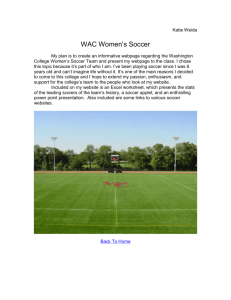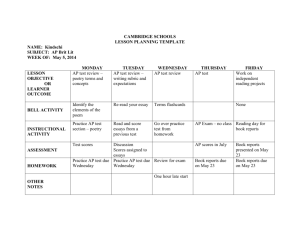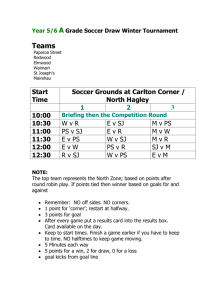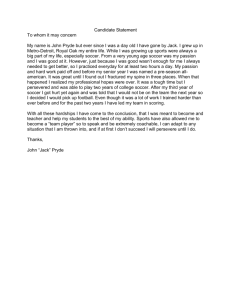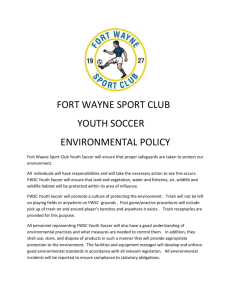DC-SCORES-Grant-Writing-Overview
advertisement
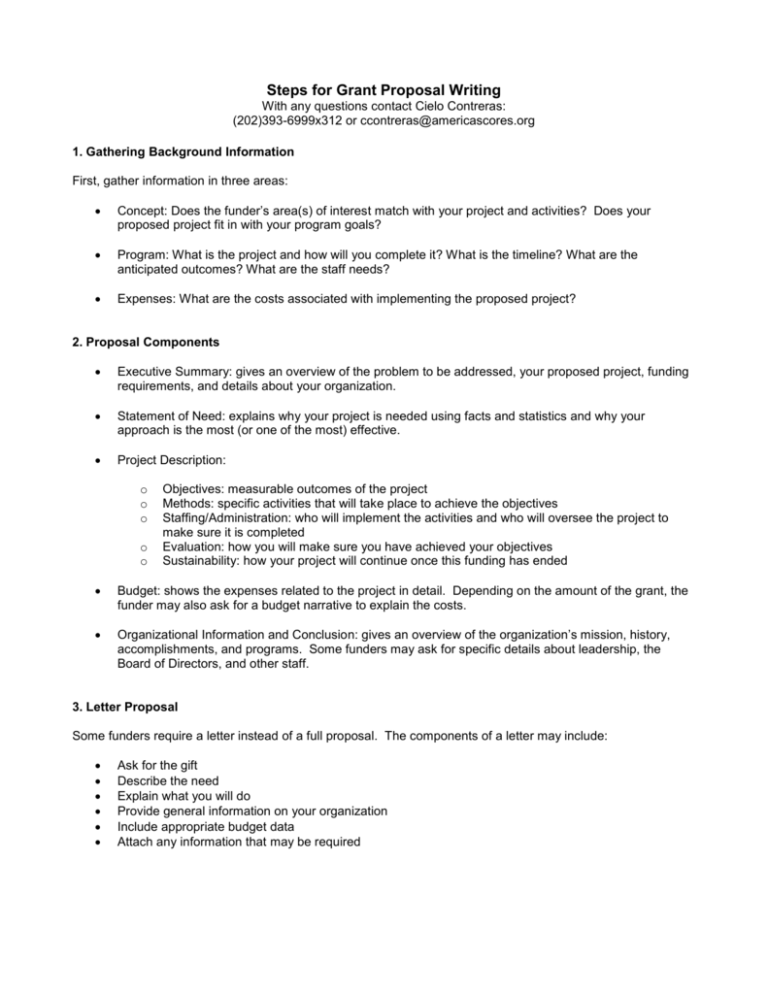
Steps for Grant Proposal Writing With any questions contact Cielo Contreras: (202)393-6999x312 or ccontreras@americascores.org 1. Gathering Background Information First, gather information in three areas: Concept: Does the funder’s area(s) of interest match with your project and activities? Does your proposed project fit in with your program goals? Program: What is the project and how will you complete it? What is the timeline? What are the anticipated outcomes? What are the staff needs? Expenses: What are the costs associated with implementing the proposed project? 2. Proposal Components Executive Summary: gives an overview of the problem to be addressed, your proposed project, funding requirements, and details about your organization. Statement of Need: explains why your project is needed using facts and statistics and why your approach is the most (or one of the most) effective. Project Description: o o o o o Objectives: measurable outcomes of the project Methods: specific activities that will take place to achieve the objectives Staffing/Administration: who will implement the activities and who will oversee the project to make sure it is completed Evaluation: how you will make sure you have achieved your objectives Sustainability: how your project will continue once this funding has ended Budget: shows the expenses related to the project in detail. Depending on the amount of the grant, the funder may also ask for a budget narrative to explain the costs. Organizational Information and Conclusion: gives an overview of the organization’s mission, history, accomplishments, and programs. Some funders may ask for specific details about leadership, the Board of Directors, and other staff. 3. Letter Proposal Some funders require a letter instead of a full proposal. The components of a letter may include: Ask for the gift Describe the need Explain what you will do Provide general information on your organization Include appropriate budget data Attach any information that may be required GRANT SEARCH RESOURCES Foundation Center - http://foundationcenter.org/findfunders/ The Foundation Center is recognized as the nation’s leader in organized philanthropy and connects grant writers and funders with tools necessary to growing and shaping their organizations. Afterschool Alliance - http://www.afterschoolalliance.org/fundingData.cfm Afterschool Alliance is the nation’s leading voice for after school programs and they offer a database of funding resources. Donors Choose - http://www.donorschoose.org/ Donors Choose allows public school teachers to post projects online and gives donors the options to pick which projects to fund and the amount of money they’d like to donate toward the project. ANC - http://anc.dc.gov/anc/site/default.asp Some Advisory Neighborhood Commissions offer grants to eligible non-profit organizations/school groups doing good works in their communities. Youth Service America - http://www.servicewire.org/nsb/Grants-and-Awards Youth Service America’s National Service Briefing provides a list of grants and funding opportunities for organizations around the country along with a detailed profile of the grant available. Grant Wrangler - http://www.grantwrangler.com/ Grant Wrangler is a free online resource of grants available specifically to teachers in arts and humanities, health and physical education, and libraries. Aftershool.org - http://www.afterschool.org/grantsfororganizations - http://www.afterschool.org/grantsforyouth Afterschool.org provides a listing of grants/awards specifically for after-school programs and the funding necessary to support them. They have grants for two categories: organizations and youth-led projects. Pennsylvania Service-Learning Alliance -http://www.paservicelearning.org/Initiatives/21stCCLC/grants.htm Though based in Pennsylvania, this website often lists national and regional grant opportunities that apply to Washington, DC and the metro area. Program Overview DC SCORES, in operation since 1994, seeks to increase school engagement, levels of physical activity, and students’ sense of self-worth and belonging. We aim to fill gaps in an environment where students have little to no exposure to organized physical activity, childhood obesity rates are dangerously high, and literacy rates are far below average. Our program serves 25 public and public charter schools spread across Washington, DC Wards 1, 2, 4, 5, 7, and 8. Of the 800 participants, 65% are African-American, 33% are Latino, 1% are Asian, and 1% are white or other ethnicities. Approximately 80% of our students receive free or reduced price lunch. Mission & History The mission of DC SCORES is to empower students in urban communities using soccer, writing, creative expression, and service-learning. With teamwork as the unifying value, DC SCORES inspires youth to lead healthy lifestyles, be engaged students, and become agents of change in their communities. DC SCORES was founded by a DC Public School teacher who noticed the girls in her class had few constructive activities available to them after school. In 1994, Julie Kennedy began to teach the kids to play soccer each day after school. One rainy day, Kennedy began to teach her school’s first soccer team to use their minds creatively through poetry. Soon after, Kennedy introduced service-learning as a third component to the program, realizing that a cohesive and empowered team who had accomplished individual and team goals on and off the field could make an impact on their surrounding community. Today, DC SCORES is a leader amongst after-school program providers and is serving more students from under-resourced communities through soccer than any other District entity. DC SCORES aims to increase school engagement, improve physical fitness, and increase self-worth and sense of belonging for participating youth. Programs Each year, students participate in over 24 weeks of programming that combines soccer and health education two days per week, poetry and service-learning two days per week, and one day is reserved for inter-school soccer games. At the middle school level, we combine soccer and poetry or service-learning all on one programming day. The program follows a school-based model for after-school programming by hiring and training four teachers (“SCORE Corps”) from each school to administer the writing and soccer curriculum, which combines academic enrichment modules, health & nutrition lessons, project planning templates, and readily usable soccer practice plans that incorporate team building and leadership activities. Our curricula are also aligned to each age group’s academic and physical education standards as defined by DC Public Schools. Power of Poetry (fall semester): This curriculum teaches students how to write, analyze and perform various forms of individual and group poetry. Through the word games and fun writing activities in the curriculum, students in DC SCORES learn to see poetry and writing as something other than a school assignment. They begin to see it as a way to express their thoughts and feelings and tell others about themselves. (Curriculum developed in partnership with the University of Iowa’s Writer’s Workshop.) Writing for the Community (spring semester): DC SCORES students examine their community and then focus on one issue to address through this project-based curriculum. As a team, the students develop and implement their project to help their community. Past projects have included organizing a school-wide clothing drive for the homeless, community gardens and tackling school safety. (Curriculum reviewed by the University of Washington.) Soccer and health (year round): DC SCORES’ soccer and health curriculum is a progression of technical skill building as well as tactical understanding of the game combined with activities designed to teach students proper nutrition, health, and physical fitness. Each day’s session incorporates teamwork, leadership and commitment. These characteristics are also awarded seasonally through the America SCORES patch program. All students participate in DC SCORES’ city-wide soccer league. (Curriculum approved by National Soccer Coaches Association of America.) Each of our schools participates in our city-wide elementary and middle school soccer leagues, the first and only of their kind within DCPS. In addition to daily programming, students, coaches and families participate in several city-wide events throughout the school year that showcase and celebrate our students’ work with DC SCORES in a fun, positive environment. Our events include a Fall Frenzy and Jamboree! (city-wide soccer tournaments), poetry readings at Starbucks, and the annual Poetry Slam!, a spoken word competition for all 800 DC SCORES students. Issues Addressed DC SCORES addresses the intersection of prevalent issues such as declining test scores and literacy rates, rising school dropout rates, and skyrocketing obesity and inactivity rates among youth. Simply put, DC SCORES believes that students who are healthy, have a strong sense of self, and are praised for their creative writing and public speaking attend, participate, and excel in a formal school environment. DC SCORES provides over 90 hours of academic enrichment and language arts instruction annually. Compared to 11 of the nation’s largest urban centers, the District of Columbia has the highest percentage of below basic readers.1 According to the DC Office of the State Superintendent (OSSE), only 45% of elementary school students in the District scored "proficient" in reading on the 2010 DC CAS standardized test.2 Additionally, Washington, DC has the ninth highest obesity rate (35.4%) in the country for children ages 10-17.3 This is due to a lack of school-based physical education, healthy food options, and safe places for children to play in the District.4 There is a growing body of research dedicated to the connection between adolescent obesity and school performance. One study found that the more physical fitness tests elementary and middle school students passed, the better they did on academic tests.5 The evidence suggests, then, that programs like DC SCORES, where students receive over 120 hours of physical activity annually through soccer, benefit students both mentally and physically. Measurable Results In 2009, we completed our first outcomes evaluation using newly created tools to measure our three main goals for youth: (1) increase school engagement; (2) increase levels of physical fitness; and (3) increase self-worth and sense of belonging. We utilized student pre- and post-surveys to measure attitudinal changes based on our program model towards self, peers, school, coaches, and the community. In addition, we measured physical fitness through a program called FitnessGram, which is designed to measure aerobic capacity, body composition, and muscular strength. Some of the highlights from the report, published January 2010, include: We found a relationship between liking and participating in DC SCORES and levels of school engagement and sense of belonging and self-worth. Specifically, by the end of the program: 81% of middle school students indicated they liked school (7% increase). 93% of students said they feel safe around their teachers (11% increase). 92% of students said they feel their soccer coach is supportive (11% increase). 74% of students found their writing coaches approachable (7% increase). At the conclusion of the program, the majority of elementary students reported that most or all of the time they get along with teachers (78%), participate in class (90%), and get along with other students (80%). For both elementary and middle school participants, we found marked improvements in cardiovascular fitness and students who either decreased or maintained body mass index (BMI). The number of boys and girls in the “normal” BMI classification increased by 8% and 3%, respectively. The number of boys classified as “overweight” or “obese” decreased by 10% and 2%, respectively. The number of girls classified as “obese” decreased by 3%. The number of laps each participant could run during the test increased by an average of 10 laps. National Center for Education Statistics, National Assessment of Educational Progress – Reading, 2007. “No Child Left Behind Data Reports.” DC Office of the State Superintendent for Education, 2010. “F as in Fat,. 2009: How Obesity Policies are Failing America” Trust for America’s Health, 2009. 4 Ibid. 5 Chomitz, Virginia R., et al. “Is There a Relationship Between Physical Fitness and Academic Achievement? Positive Results From Public School Children in the Northeastern United States,” Journal of School Health 79, no. 1 (2009): 30-37 1 2 3


